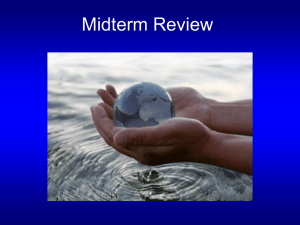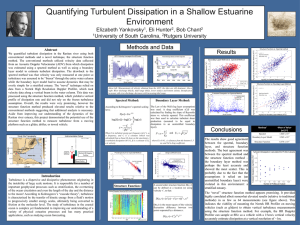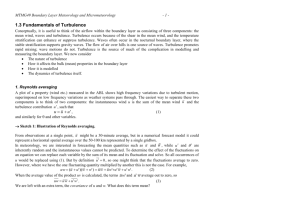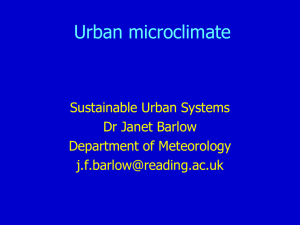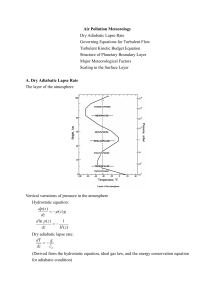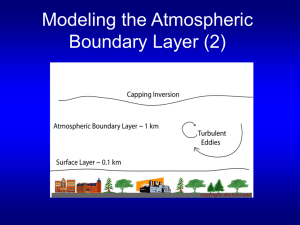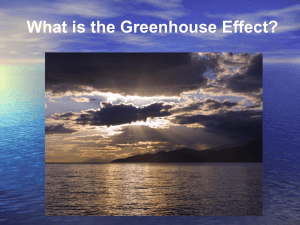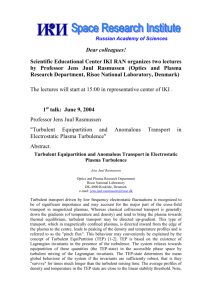Midterm Review
advertisement
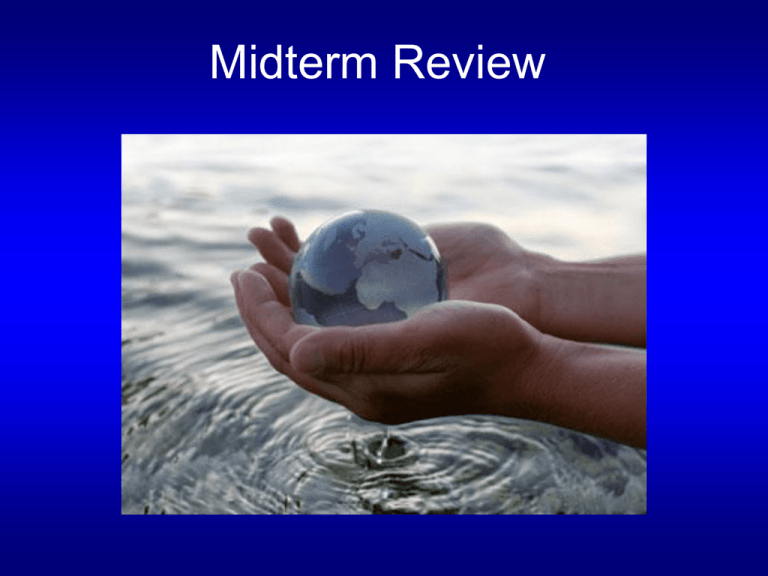
Midterm Review What have we discussed? • • • • • • • • • • • • Importance of the atmospheric boundary layer Surface energy balance Surface water balance Vertical structure of the ABL Modeling the ABL Startocumulus-topped boundary layer Boundary layer of shallow and deep convection Land surface processes Air pollution Climate feedbacks for global warming Ocean-atmosphere interaction Abrupt climate change Importance of the ABL • The mission of meteorology is to understand and predict weatherrelated disasters (e.g. tornados, hurricanes, winter storms) and climate-related disasters (e.g. El Nino and global warming). • The modern climatology (meteorology) was born in the 1940s (a very young science!), but has been growing very fast! Now we have a global observational network with many satellites, ships, radars and surface stations, as well as very comprehensive prediction models running on the world’s fastest supercomputers. • The current status of weather and climate predictions: (1) weather prediction good to 10 days, (2) tropical cyclone prediction good in track but not in intensity, (3) climate prediction good to two seasons, (4) climate change projections have a 3-fold difference in magnitude. • The main reasons of the difficulties: (1) Teleconnection problem, (2) Feedback problem, and (3) Subgrid-scale problem. • Importance of the ABL: (1) interface between atmosphere and ocean/land/ice - flux transfer and feedback, (2) the human beings are living in the ABL and change the environment, (3) a basic subgridscale process Surface energy balance – – – – – – – What is energy? 3 methods of energy transfer The names of the 6 wavelength categories in the electromagnetic radiation spectrum. The wavelength range of Sun (shortwave) and Earth (longwave) radition Earth’s energy balance at the top of the atmosphere. Incoming shortwave = Reflected Shortwave + Emitted longwave Earth’s energy balance at the surface. Incoming shortwave + Incoming longwave = Reflected shortwave + Emitted longwave + Latent heat flux + Sensible heat flux + Subsurface conduction What is sensible heat flux? What is latent heat flux? Bowen ratio B= SH/LH = Cp(Tsurface - Tair) / L(qsurface - qair) provides a simple way for estimating SH and LH when the net radiative flux Fr is available LH=Fr/(B+1), SH=Fr B/(B+1) Other heat sources: precipitation, biochemical, anthropogenic The Electromagnetic Spectrum The limitations of the human eye! Summary: Surface energy balance Incoming shortwave + Incoming longwave = Reflected shortwave + Emitted longwave + Latent heat flux + Sensible heat flux + Subsurface conduction SWdn =Scos SWup =SWdn LWdn LWup =Tair4 =Ts4 LH=CdLV(qsurface- qair) SH=CdCpV(Tsurface- Tair) dT/dt Fc = - dT/dz Surface water balance • Global water cycle • Surface water balance • Soil moisture: Increases with depth • Palmer drought severity index (PDSI): uses temperature and rainfall • Desertification The global water cycle Surface water balance The changing rate of soil moisture S dS/dt = P - E - Rs - Rg + I Precipitation (P) Evaportranspiration (E=Eb+Ei+Es+TR) Irrigation (I) Runoff (Rs) dS/dt (PDSI, desertification) Infiltration (Rg) Vertical structure of the ABL • Vertical structure of the atmosphere and definition of the boundary layer • Vertical structure of the boundary layer • Definition of turbulence and forcings generating turbulence • Static stability and vertical profile of virtual potential temperature: 3 cases. Richardson number • Boundary layer over ocean • Boundary layer over land: diurnal variation Vertical Structure of the Atmosphere • • Definition of the boundary layer: "that part of the troposphere that is directly influenced by the presence of the earth's surface and responds to surface forcings with a time scale of about an hour or less.” Scale: variable, typically between 100 m - 3 km deep Vertical structure of the boundary layer From bottom up: • Interfacial layer (0-1 cm): molecular transport, no turbulence • Surface layer (0-100 m): strong gradient, very vigorous turbulence • Mixed layer (100 m - 1 km): well-mixed, vigorous turbulence • Entrainment layer: inversion, intermittent turbulence Static Stability • Static stability – refers to atmosphere’s susceptibility to being displaced • Stability related to buoyancy function of temperature • The rate of cooling of a parcel relative to its surrounds determines its ‘stability’ of a parcel • For dry air (with no clouds), an easy way to determine its stability is to look at the vertical profile of virtual potential temperature v = (1 + 0.61 r ) Where = T (P0/P)0.286 is the potential temperature r is the water vapor mixing ratio Three cases: (1) Stable (sub-adiabatic): v increases w/ height (2) Neutral (adiabatic): v keeps constant w/ height (3) Unstable (super-adiabatic): v decreases w/ height Stable or sub-adiabatic Neutral or adiabatic Unstable or super-adiabatic Diurnal variation of boundary layer over land • Daytime convective mixed layer + clouds (sometimes) • Nocturnal stable boundary layer + residual layer (leftover of daytime convective mixed layer) Modeling the ABL • Reynolds averaging: Separation of mean and turbulent components u = U + u’, < u’ > = 0 • Intensity of turbulence: turbulent kinetic energy (TKE) TKE = ‹ u’ 2 + v’ 2 + w’ 2 › /2 • Eddy fluxes Fx = - <u’w’>/z • The turbulent closure problem: Number of unknowns > Number of equations • Surface layer: related to gradient • Mixed layer: Local theories (K-theory): < w’a’ >= - Ka dA/dz always down-gradient Non-local theories: organized eddies filling the entire BL, could be counter-gradient Reynolds averaging (1) Separate mean and turbulent components Assume you are given a time series of zonal wind speed u for a period of one hour, the zonal wind speed can be decomposed into two components: u = U + u’ where U = < u > is the time average (< > means time average, over one hour here) and is called the time mean component, while u’ is the fluctuation around U, i.e. u’ = u - U and is called the turbulent component. (2) Do time average <U>=U < u’ > = 0 < A u’ > = A < u’ > = 0 Only cross terms <a’b’> are left. They are also called non-linear terms. Intensity of turbulence: Turbulent kinetic energy (TKE) Mean kinetic energy MKE = (U2 + V2 + W2)/2 Turbulent kinetic energy TKE = ‹ u’ 2 + v’ 2 + w’ 2 › /2 ‹› Time evolution (diurnal) represents time average Vertical profile The turbulence closure problem • For large-scale atmospheric circulation, we have six fundamental equations (conservation of mass, momentum, heat and water vapor) and six unknowns (p, u, v, w, T, q). So we can solve the equations to get the unknowns. • When considering turbulent motions, we have five more unknowns (eddy fluxes of u, v, w, T, q) • We have fewer fundamental equations than unknowns when dealing with turbulent motions. The search for additional laws to match the number of equations with the number of unknowns is commonly labeled the turbulence closure problem. Mixed layer theory I: Local theories • K-theory: In eddy-diffusivity (often called K-theory) models, the turbulent flux of an adiabatically conserved quantity a (such as θ in the absence of saturation, but not temperature T, which decreases when an air parcel is adiabatically lifted) is related to its gradient: < w’a’ > = - Ka dA/dz • The local effect is always down-gradient (i.e. from high value to low value) • The key question is how to specify Ka in terms of known quantities. Three commonly used approaches: (1) First-order closure (2) 1.5-order closure or TKE closure (3) K-profile Mixed layer theory II: Non-local theories • • • • • Any eddy diffusivity approach will not be entirely accurate if most of the turbulent fluxes are carried by organized eddies filling the entire boundary layer. The non-local effect could be counter-gradient. Consequently, a variety of ‘nonlocal’ schemes which explicitly model the effects of these boundary layer filling eddies in some way have been proposed. A difficulty with this approach is that the structure of the turbulence depends on the BL stability, baroclinicity, history, moist processes, etc., and no nonlocal parameterization proposed to date has comprehensively addressed the effects of all these processes on the large-eddy structure. Nonlocal schemes are most attractive when the vertical structure and turbulent transports in a specific type of boundary layer (i. e. neutral or convective) must be known to high accuracy. Stratocumulus-topped Boundary Layer • • • • Definition of stratocumulus clouds Global distribution Importance for global warming Vertical structure and formation mechanism of STBL • Modeling of STBL: non-local forced by surface heating and cloud-top cooling Global distribution of stratocumulus clouds Distributed over eastern part of subtropical oceans Vertical structure and formation mechanism of stratocumulus-topped boundary layer (STBL) • Intense longwave radiative cooling at cloud top drives eddies in BL • Eddies pick up moisture and maintain cloud • Eddies also entrain warm, dry air from above the inversion • Entrainment lifts the cloud, large-scale subsidence lowers it Boundary layer of shallow and deep convection • Global distribution of shallow and deep convection • Vertical structure of trade wind cumulus (shallow convection) • Vertical structure of deep convection. Four components: convective updraft, convective downdraft, mesoscale updraft, mesoscale downdraft • Differences between shallow convection and deep convection: change of T, q and h in the boundary layer • Self-suppression processes in deep convection: Overly stabilized state after deep convection • Problems in current global climate models: lack of selfsuppression processes Hadley circulation and cloud types Tropics L Deep convection H Trade wind cumulus Stratocumulus Trade wind cumulus • Cloud top height generally below 4 km • Often associated with light rain • Sometimes topped by stratocumulus Vertical structure and self-suppression processes in deep convection Convective updrafts Mesoscale updrafts Mesoscale downdrafts Convective downdrafts Onion sounding Differences in boundary layer between shallow convection and deep convection Shallow: T decreases Deep: T decreases Shallow: q increases Deep: q decreases Shallow: h keeps const Deep: h decreases Effects of human activities Human beings are living in the BL and affect the BL in three different ways: • Change land cover (deforestation and afforestation) • Release or cleanse pollutants (aerosols) • Release or cleanse greenhouse gases Land surface processes • Effects of different surface types: desert, city, grassland, forest, sea. Deeper heat/water reservoir, decreased Bowen ratio, thinner BL and enhanced convective instability. • Effects of vegetation: (1) makes heat/water reservoir deeper, (2) enhance evaporation, (3) grows and dies in response to environmental conditions • Heat island effect. 7 causes • Community land model (CLM). 4 components: biogeophysics, hydrological cycle, biogeochemistry, dynamical vegetation Effects of different surface types BL depth decreases Convective instability increases Deeper heat reservoir (smaller T change) Deeper water reservoir (Wetter surface) Bowen ratio decreases (More LH contribution) Effects of vegetation • Makes water/heat reservoir deeper (transport deep water out of soil) • Enhances evaporation (leafs increase evaporation area) • Dependent on vegetation type The heat island effect • Nighttime: City warmer than surrounding rural area • Daytime: City has same air temperature as rural area Causes of the heat island effect • Increased SW absorption caused by canyon geometry (increased area and multiple reflection) • Decreased LW loss caused by canyon geometry • Increased greenhouse effect caused by air pollution • Anthropogenic heat source • Increased sensible heat storage caused by construction materials • Decreased latent heat flux caused by change of surface type • Decrease sensible and latent heat fluxes caused by canyon geometry (reduction of wind speed) “Canyons” between buildings Air pollution • Air pollution. 2 categories • 6 types of major pollutants: particulates, carbon oxides, sulfur dioxides, nitrogen oxides, volatile organic compounds, ozone • Air quality index • Atmospheric Conditions and Air Pollution (1) effect of wind, (2) effect of stability and turbulence • History of air pollution: The Medieval pollution, The 16th19th centuries, The 20th century, The 21st century Inversions • Inversions are absolutely stable and free of eddies • Inversions can trap pollutants near the Earth’s surface. Low level inversion Upper level inversion (most dangerous) Climate feedbacks for global warming • Large spread in projected temperature change comes from uncertainties in climate feedbacks • Main climate feedbacks for global warming: albedo, lapse rate, water vapor, cloud, aerosol, carbon cycle • Feedback strength in climate models: cloud feedback causes the largest uncertainty Ocean-Atmosphere Interaction • Mean state: The two basic regions of SST? Which region has stronger rainfall? What is the Walker circulation? Two types of ocean upwelling • Mean state: ocean-atmosphere feedback • ENSO: Which region has warm SST anomaly during El Nino? 4year period. • Existing ENSO theories • AMO and thermohaline circulation Abrupt Climate Change • • • • Past abrupt climate change Tipping points Future abrupt climate change Mitigation: International (Kyoto Protocol), Green economy (Renewable energy, Sustainable transportation, Green buildings, Energy-efficient industry and carbon capture, Land management, afforestation, waste management) Important • Please remember to bring your calculator to the exam!
